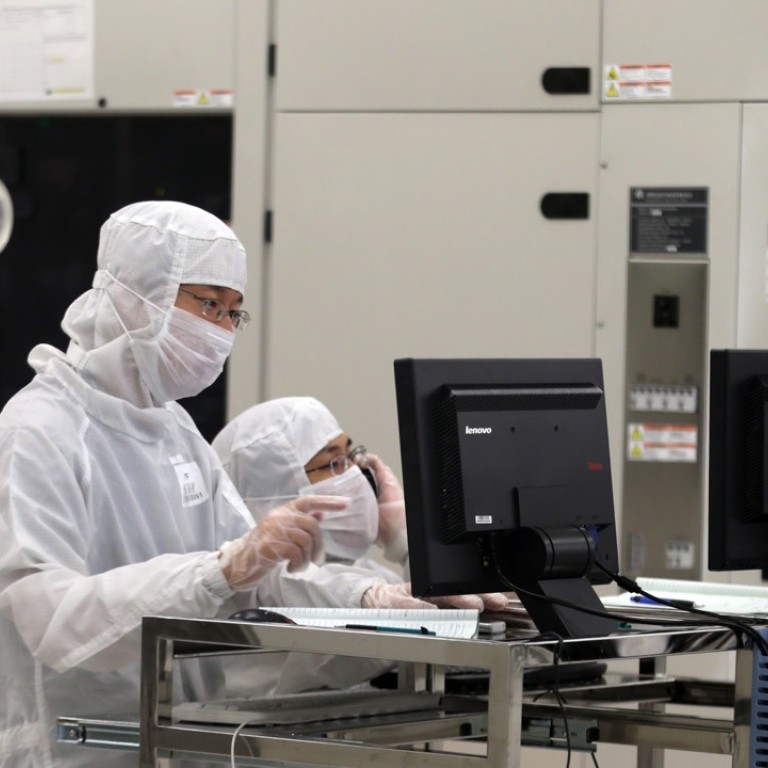
China must face its weakness in semiconductors squarely, says head of state-backed fund
China’s dependence on US chip technology was laid bare in April when the US government slapped an export ban on ZTE, crippling the Chinese telecommunications equipment maker
China must invest heavily to develop its own advanced chips to close the gap with the United States, after the forced shutdown of ZTE Corp earlier this year exposed the country's weakness in a core technology, according to the head of the nation's state-backed semiconductor investment fund.
“Everyone is aware that the global situation is complicated, we must face the situation squarely,” Ding Wenwu, president of the National Integrated Circuit Industry Investment Fund, also known as the Big Fund, said in a speech at the Smart Expo conference in Chongqing on Friday. “The incident in the first half has made the average man-in-the-street understand about chips. Previously, people only knew about mobile handsets.”
Ding’s remarks followed a statement made by President Xi Jinping on Thursday in the same conference, where he broadly reiterated China’s efforts to keep pace and collaborate with information technology initiatives around the world.
“China pays serious attention to innovative development,” said Xi in the statement read at the event by vice-premier Han Zheng. “The country will speed up the development of both [its] digital industry and the digitalisation of industries. China wants to actively participate and cooperate in global digital developments.”
Those views presented at the conference reflect the urgency of China’s commitment to develop a strong domestic semiconductor supply chain, which would enable the country to become more competitive with chip industry leader the US.
Semiconductors are at the centre of a technology gap that China wants to close. These integrated circuits go into and power everything from smartphones to smart speakers to the most advanced super computers and driverless cars.
No mainland Chinese semiconductor company has so far been able to crack the world’s top 20 ranking in terms of chip sales, which are dominated by companies from the US, Japan, South Korea and western Europe. Three Taiwanese firms – Taiwan Semiconductor Manufacturing Company, MediaTek and United Microelectronics Corp – were among those in the top 20, according to data from IC Insights.
The Big Fund was set up in 2014 by China's central government to lead the national effort to catch up in the global semiconductor industry by raising funds and backing semiconductor start-ups and research and development. The goal: help China become self-sufficient in chips that are used by the country's vast manufacturing supply chain.
China makes more than 90 per cent of the world’s smartphones, 65 per cent of personal computers and 67 per cent of smart televisions, according to estimates from Bernstein Research. But it has had to buy much of the chips that go into these devices from abroad. Annual chip imports by China have risen to more than US$200 billion since 2013 and reached US$260 billion last year.
To close the technology gap, the Big Fund will work with investors to “plug shortcomings and extend advantages,” Ding said in his speech. He said that the fund has “operated relatively smoothly” in the four years since it was set up.
China should put in resources to develop central and graphic processing units, he said. Currently, the country occupies the low- to mid-end of the semiconductor market and has to import advanced semiconductors, which has contributed to a trade deficit in chips, he said.
Still, China's “enormous market is also its opportunity” to develop the semiconductor industry, he said. Developing chips will go toward support smart manufacturing, he said.
The Big Fund is reportedly planning to raise 150 billion yuan to 200 billion yuan as a second batch to add to its war chest.
The fundraising round was said to have been in the pipeline before the US-China trade war. A round of talks between the two countries concluded this week with no concrete steps toward ending the trade war that started last month.
Investments made by the Big Fund would cover chip companies for “all applications, including those used for smart cars, artificial intelligence and internet of things”, Ding told the South China Morning Post on the sidelines of the conference.
China's State Council set a near-term goal of growing annual domestic semiconductor revenue from 2015 to 2020, and become a global leader in all segments of the semiconductor supply chain by 2030. Towards that end, the policy outlined the creation of an industry investment fund to drive semiconductor capacity and push forward a restructuring in the domestic chip industry.
In 2015, the central government introduced its “Made in China 2025” plan, in which semiconductors and related equipment are under the policy’s “new information technology” sector.
China, which is heavily dependent on semiconductor imports, accounted for more than 60 per cent of annual global chip sales, according to data from PwC. Semiconductors represent one of the top exports of the US, along with aircraft, refined oil and cars.

